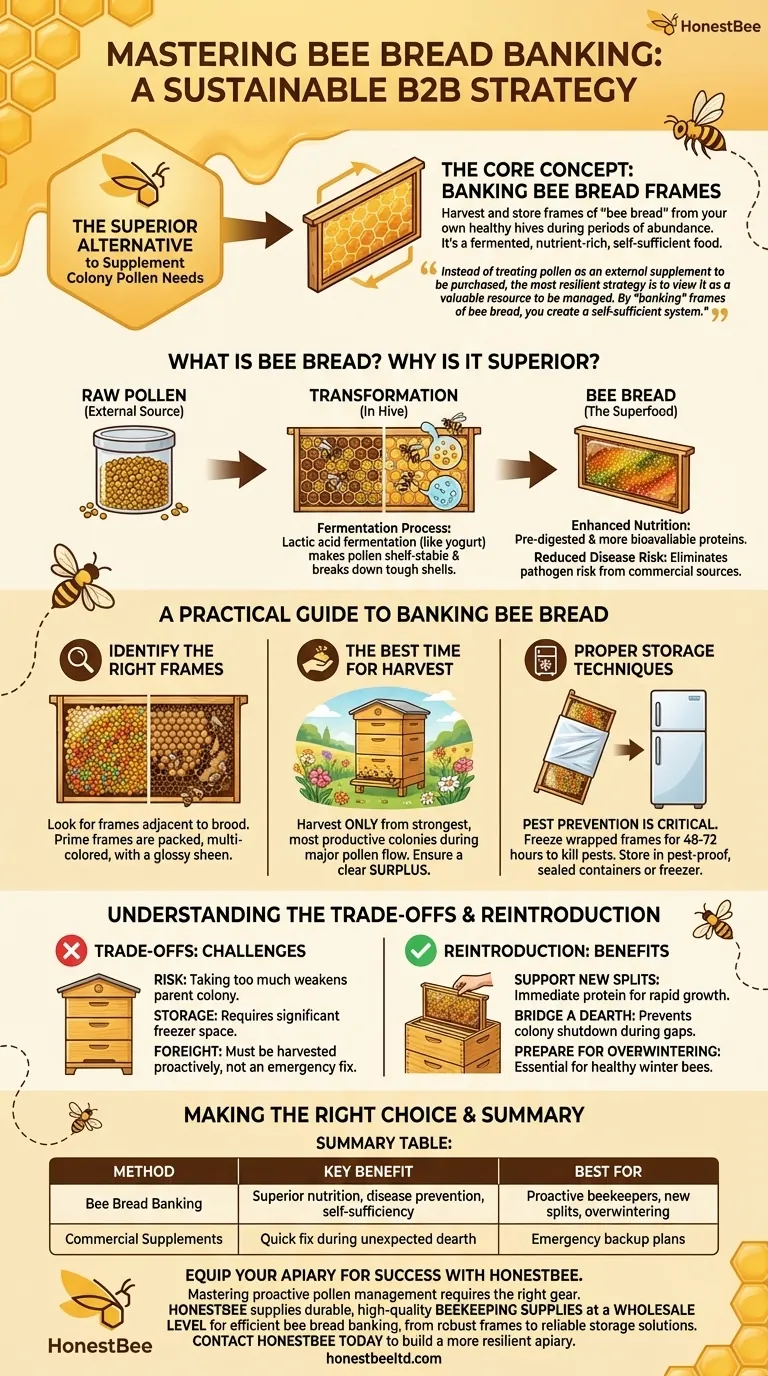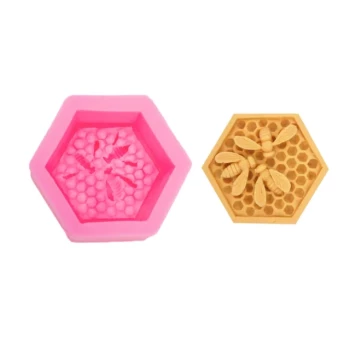The most effective alternative to supplement colony pollen needs is to harvest and store frames of "bee bread" from your own healthy hives during periods of abundance. This hive-produced resource is a fermented, nutrient-rich food that is far more beneficial and safer for bees than externally sourced raw pollen or artificial patties.
Instead of treating pollen as an external supplement to be purchased, the most resilient strategy is to view it as a valuable resource to be managed. By "banking" frames of bee bread during peak season, you create a self-sufficient system that supports your bees with their own perfectly formulated food when they need it most.

What is Bee Bread and Why is it Superior?
Understanding the difference between raw pollen and bee bread is crucial. Bees don't eat the raw pollen pellets they carry into the hive; they transform them into a non-perishable, highly nutritious food source.
The Fermentation Process
Bees pack pollen into cells, mix it with nectar and their own glandular secretions, and cap it. This initiates a lactic acid fermentation process, much like making sauerkraut or yogurt.
This natural preservation process makes the pollen shelf-stable within the hive and, more importantly, breaks down the tough outer shell of the pollen grains.
Enhanced Nutritional Value
Fermentation makes the proteins and nutrients in the pollen significantly more digestible and bioavailable for the bees. Bee bread is a pre-digested superfood tailored by the bees, for the bees.
Reduced Risk of Disease
Using frames from your own apiary eliminates the significant risk of introducing diseases like American Foulbrood (AFB). Commercial pollen sources are often collected from thousands of different hives, creating a potential pathway for pathogens to enter your apiary.
A Practical Guide to Banking Bee Bread
This is a proactive strategy that requires planning during the season's peak, not a reactive fix during a crisis.
Identifying the Right Frames
Look for frames adjacent to the brood nest, as this is where nurse bees need easy access to protein. A prime frame will have cells packed with multi-colored pollen, often with a glossy sheen on top where bees have added honey or nectar to begin the ensiling process.
The Best Time for Harvest
Harvest frames only from your strongest, most productive colonies during a major pollen flow. You are looking for a clear surplus—frames that are heavy with bee bread beyond the immediate needs of the brood nest.
Proper Storage Techniques
Pest prevention is the most critical step. Frames of bee bread are highly attractive to wax moths and hive beetles.
The best method is freezing. Tightly wrap the frames in plastic wrap or place them in large plastic bags, and freeze them for at least 48-72 hours. This kills all life stages of any potential pests. After freezing, they can be stored in a sealed, pest-proof container or freezer.
Understanding the Trade-offs
While highly effective, this method requires careful judgment and management.
Risk of Weakening the Parent Colony
The primary risk is taking too much. Removing too many pollen frames can stress the colony you harvested from, hindering its ability to raise brood and potentially impacting its winter survival. Only ever take what is clearly surplus.
Storage Demands
Storing full-sized frames requires significant freezer and storage space. This might be a logistical challenge for beekeepers with many hives or limited space.
It Requires Foresight
This is not an emergency solution. You cannot create bee bread when your bees are starving during a pollen dearth. It must be harvested and stored months in advance, demanding a proactive management mindset.
How to Reintroduce Stored Frames
When the time comes, reintroducing the frames is simple and effective.
Supporting New Splits and Swarms
Late-season splits or captured swarms benefit immensely from an immediate protein source. Place a thawed frame of bee bread directly next to their brood nest to give the new queen and nurse bees the resources they need to ramp up egg-laying and development quickly.
Bridging a Pollen Dearth
During a mid-summer gap in flowering plants or a long period of bad weather, a frame of bee bread can prevent a colony from shutting down brood production. This ensures the colony maintains a strong population.
Preparing for Overwintering
A colony's ability to survive winter depends on the healthy, long-lived "winter bees" raised in the fall. Placing a frame of bee bread in the hive in early autumn guarantees they have the protein needed to raise this critical generation.
Making the Right Choice for Your Goal
- If your primary focus is self-sufficiency and disease prevention: Banking your own bee bread frames is the gold standard, creating a closed-loop system free from external contaminants.
- If your primary focus is raising strong nucleus colonies or splits: Having frozen frames of bee bread on hand is the most powerful tool for ensuring their rapid and healthy growth.
- If your primary focus is getting through an unexpected dearth: Stored frames are the ideal solution, but if you have none, high-quality commercial supplements are a necessary backup plan.
By learning to manage your hives' resources proactively, you shift from simply keeping bees to becoming a truly sustainable beekeeper.
Summary Table:
| Method | Key Benefit | Best For |
|---|---|---|
| Bee Bread Banking | Superior nutrition, disease prevention, self-sufficiency | Proactive beekeepers, new splits, overwintering |
| Commercial Supplements | Quick fix during unexpected dearth | Emergency backup plans |
Equip Your Apiary for Success with HONESTBEE
Mastering proactive pollen management is key to sustainable beekeeping. For commercial apiaries and distributors, having the right equipment is just as crucial as having the right strategy.
HONESTBEE supplies the durable, high-quality beekeeping supplies and equipment you need to efficiently implement practices like bee bread banking. From robust frames for harvesting to reliable storage solutions, we support your operations at a wholesale level.
Ready to build a more resilient and self-sufficient apiary? Contact HONESTBEE today to discuss your equipment needs and how we can help your business thrive.
Visual Guide

Related Products
- Wooden Bee Hive Frames for Beekeeping and Wholesale
- Plastic Bee Hive Stand for Beekeeping
- Copper Bee Frame Eyelets for Beekeeping
- Yellow Plastic Bucket Pail Perch for Beekeeping
- Professional Insulated Winter Hive Wrap for Beekeeping
People Also Ask
- What are the primary uses of different Langstroth frame sizes? Optimize Your Hive for Health & Honey
- What is the role of oxalic acid in plants? A Key to Plant Defense and Internal Regulation
- Will honey bees clean up old frames? A Guide to Safe and Efficient Frame Reuse
- What color options are available for plastic frames, and what is the benefit of black frames? Boost Your Hive Inspection Efficiency
- What types of beehive frames are compatible with the honey press? A Guide to Crush-and-Strain Extraction



















